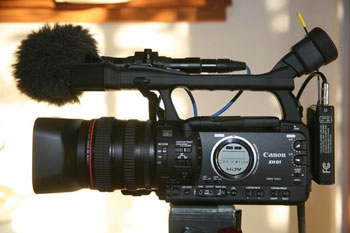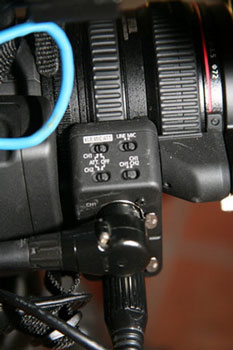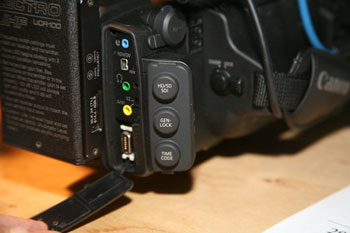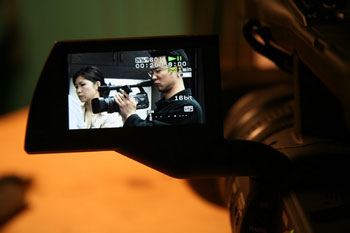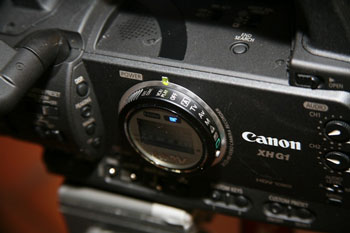 |
→ November 2006 Contents → Camera Corner
|
Camera Corner:
Review of the Canon XH G1 and XH A1 Camcorders November 2006
|
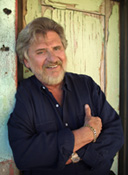 |
||||||||||||||||||
|
Earlier this year, Canon introduced its first High Definition DV camcorder, the XL H1. In my opinion and those of many critics, it is the best High Definition camcorder on the market in its price range. When comparing the Canon to other manufacturers the overwhelming opinion was that for picture quality it couldn't be beat. A lot of this is attributable to its Fluorite 20X lens. Anyone who has shot any quantity of High Def video can tell you that focusing in that format as opposed to Standard Definition becomes critical. In High Def, any slight lack of focus, which would be tolerable in SD, becomes a glaring glitch. But when I reviewed the XL H1, I also offered the caveat that this was not a camera for a video journalist; it was simply too big for the kind of work VJs do. What we needed more than anything else was a High Definition version of the smaller GL 2. Sony's Z1U arrived two and a half years earlier, and was perfect for this market. As a result, it quickly became "the" camera for video journalism.
This month the camera that these people had been waiting for finally hits the stores. Actually, it comes in two versions, the XH G1 for $7,500, and the XH A1 for $3,750. They are essentially the same cameras. The only difference is that the more expensive version has a broadcast "jack box" (the Jackpack) built in (more about that later).
OVERVIEW OF THE CAMERA:
The G1 and the A1 are both beauties to behold. They are slightly smaller than the Sony Z1U weighing about 4.5 pounds. Like the XL H1 they are a professional looking all-black. They are meant to be handheld as opposed to shoulder-mounted like the Z1U, and their predecessor, the Canon GL 2. They shoot UNCOMPRESSED HD in HDSDI, which means they deliver an image of 1440x1080, as opposed to competing cameras, which shoot 960X1080. In addition to its widescreen 0.57" color viewfinder it has an LCD panel which swings out from the top of the camera itself, unlike the Sony, which swings down from the handle. The LCD is 2.8-inch widescreen, which displays approximately 207,000 pixels.
The camera has a stereo mic built into the front of the handle, and also two XLR inputs on the side of the camera. There are switches above the inputs that allow the camera to be switched between XLR input 1 and 2, or to engage both. This feature, which is available inside the control door on the XL H1 and previous cameras, is now in the right place where it can easily be accessed during an interview. There is a secure bracket for an external mic such as a Senheiser MK 64 on the side of the handle.
The camera records still photos in the 16:9 aspect ratio at approximately 1.56 mega pixels on a SD memory card. However, as many newspaper photographers are discovering, there are now solutions that allow these files to be enhanced by a factor of 8 for publication.
A TOUR OF THE CAMERA:
In front of the control wheel are switches for ND filters (1/6 and 1/32), below that the push AF lock, and to the right, a position preset which operates either focus or zoom presets, which can be used for "rack focus." Below that is the AF/M switch.
Just to the immediate left of the control wheel is auto gain and auto white balance switches.
One very cool feature is the battery compartment, which is now behind a door on the rear of the camera. It holds batteries of various sizes, which can allow you to get up to 7 hours of recording time off of one battery. Why the door is a good idea is that it means you can put a strip of Velcro on it to hang your wireless receiver from. On the tape compartment side of the camera are a zoom speed switch and a tape/memory card switch.
On the XH G1 (not on the A1) is the $2,500 do-hickey. This is the Professional Jackpack ("jack box"), which allows you to plug in HD/SDI, Genlock, and Time Code cables. This feature is really intended for broadcasters. It allows the camera to be driven by remote controls in a studio, or synch to one or more other cameras for interviews.
FIELD TESTING THE CAMERA:
As noted above the camera is a pleasure to hold. The controls are where a professional wants them. No more fumbling for bars or iris controls.
The iris control on the lens barrel, right behind the focus ring, is something we have all been waiting for, which previously was only available on ENG cameras. The zoom control can be adjusted to be very fast, just like on a professional broadcast camera.
The stabilization control is also enhanced. I am told it can be effectively used with even such extreme vibration situations as on a helicopter. It detects shake by gyro-sensor.
The CCD chip set is exactly the same as in the $9,000 XL H1. This means that footage shot on the two cameras will match in postproduction.
When the industry went from standard definition to high definition, one of the things that suffered was low-light capability. This was true of all manufacturers. However, by waiting with its technology, Canon was able to maintain its low-light capability, and with its 36 db maximum gain this camera will do extremely well in low light.
Frankly, I have not had a chance to get into the multiple pre-set options (there are 23 image adjustments, 22 of which are customizable). You can adjust everything from gamma setting to color matrixes. This means you can customize your HL G1 to match the output from any manufacturer's camera, so that everything in post will match. If you get lost playing around in the options, you can just hit the "reset" button in the menu and it will take you back to the original defaults. Up until the XL H1, these customizations were only available on an $80,000 ENG camera.
These functions are particularly useful to organizations that employ multiple cameras, and want them all to match. All you have to do is configure one camera, then transfer that information on a SD card to the other cameras.
You can record two stereo channels in high fidelity professional standards and provide phantom power for the microphones. In addition to the two XlR inputs, there is also a separate mini plug stereo input. What I have never understood is why Canon, as well as other manufacturers, make the mic holder bigger than the industry standard Senheisser mics. That problem, of course, is easily solved with a bit of gaffer tape. The onboard stereo carderoide mic is fine for ambient sound recording, but for any professional interview use, you will need to supply your own mics.
For newspapers especially, the ability to transfer still images for use in print is a big point. The camera will capture still images at full HD resolution (1920x1080) and can be captured simultaneously as video and be transferred back to an SD card from video playback. You can also extract whatever picture information you need by choosing one of the progressive modes in playback. One of the cool things is that you can just go ahead and shoot video, then in playback when you see a frame you want to grab, just pause the camera and hit the photo button, and the picture will instantly be recorded to the SD card. This means that you can do all your still editing in camera, before you ever get back to post.
While talking about stills, if you want you can put your EOS strobe in the hot shoe on top.
The battery life is almost unbelievable at up to 7 1/2 hours. It is three times more efficient than prior cameras. In the real world, you can expect at least 4 hours per battery.
The camera that I have had for review is a prototype. Often there are small problems that are discovered in this evaluation. In my case, while putting the camera in a bag into an airline overhead bin, the mic mount snapped off. I discovered that the mount is only held on by two small, jeweler-type screws, and can easily snap off. Canon discovered this themselves when one of the show display units at PhotoPlus also had its mic mount snap off.
I experienced the same thing when the first Canon XL was introduced. In that case, the viewfinder assembly would snap off, simply by leaving it on a car seat. I went through three of those cameras in a month, but again it was because the cameras were prototypes, and once Canon found out what the problem was they strengthened the weak spot. I never had it happen again in the years I have been using the XLs, so I assume they will fix the mic mount in the next few weeks.
Other than that, it's an awesome camera. Oh, by the way, I want the wide-angle adaptor!
DISCLAIMER: CANON USA is a sponsor of the Platypus Workshops and The Digital Journalist, but has no influence over our reviews.
© Dirck Halstead
Editor and Publisher of The Digital Journalist
|
|||||||||||||||||||
Back to November 2006 Contents
|
|
